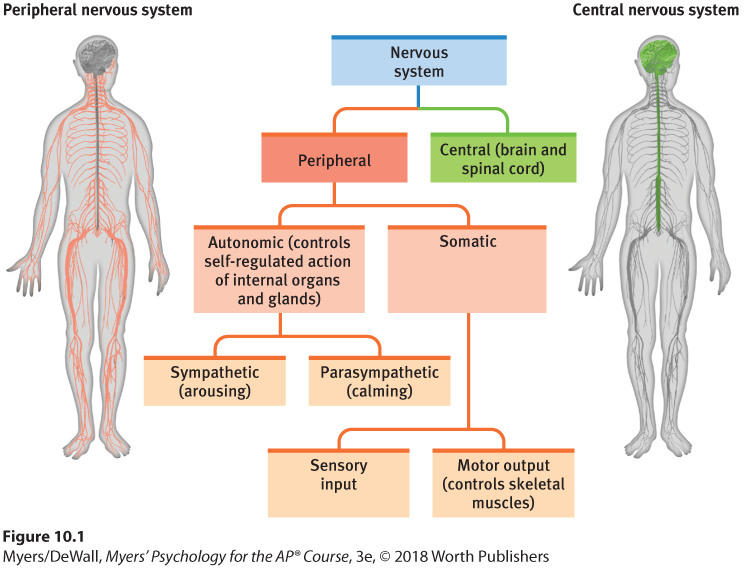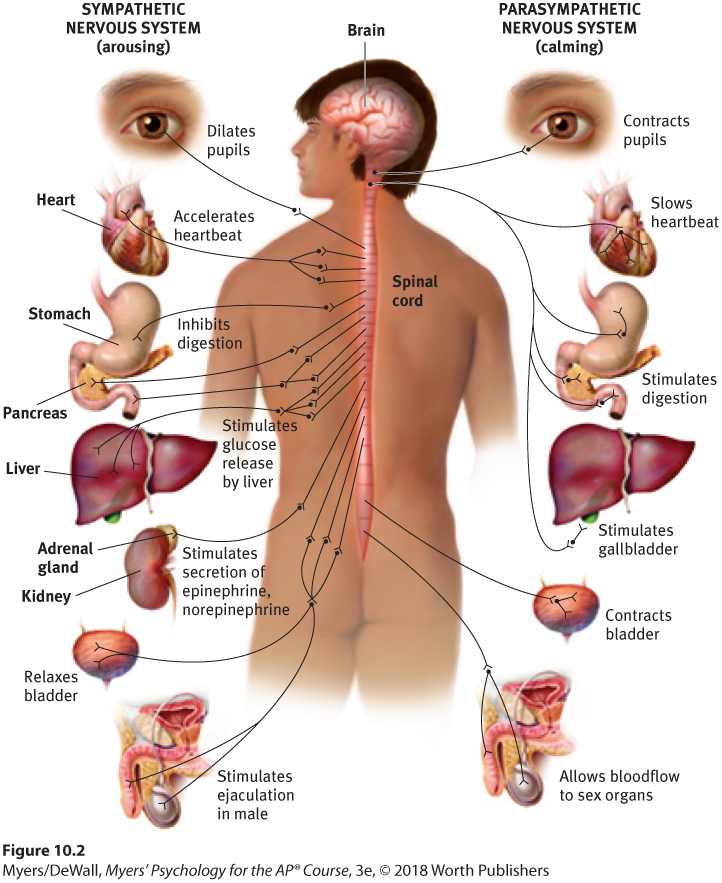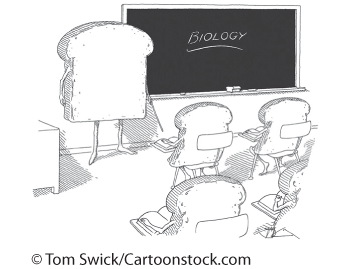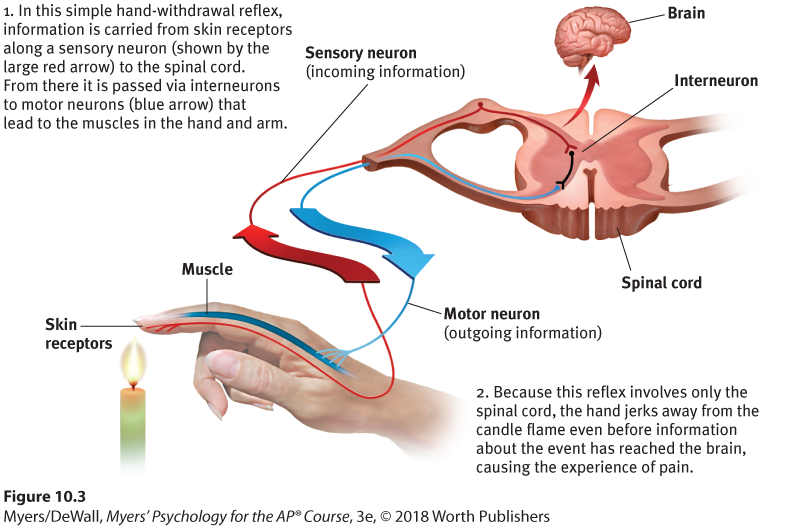The Nervous System
Neurons communicating with neurotransmitters make up our body’s nervous system, a communication network that takes in information from the world and the body’s tissues, makes decisions, and sends back information and orders to the body’s tissues (Figure 10.1).

Figure 10.1 The functional divisions of the human nervous system
A quick overview: The brain and spinal cord form the central nervous system (CNS), the body’s decision maker. The peripheral nervous system (PNS) is responsible for gathering information and for transmitting CNS decisions to other body parts. Nerves, electrical cables formed from bundles of axons, link the CNS with the body’s sensory receptors, muscles, and glands. The optic nerve, for example, bundles a million axons into a single cable carrying the messages from the eye to the brain (Mason & Kandel, 1991).
Information travels in the nervous system through three types of neurons. Sensory neurons carry messages from the body’s tissues and sensory receptors inward (thus, they are afferent) to the brain and spinal cord for processing. Motor neurons (which are efferent) carry instructions from the central nervous system outward to the body’s muscles and glands. Between the sensory input and motor output, information is processed via the interneurons of the spinal cord and brain. Our complexity resides mostly in these interneurons. Our nervous system has a few million sensory neurons, a few million motor neurons, and billions and billions of interneurons.
The Peripheral Nervous System
Our peripheral nervous system has two components—somatic and autonomic. Our somatic nervous system enables voluntary control of our skeletal muscles. As you reach the end of this page, your somatic nervous system will report to your brain the current state of your skeletal muscles and carry instructions back, triggering a response from your hand so you can turn the page and read on.
Our autonomic nervous system (ANS) controls our glands and our internal organ muscles. The ANS influences functions such as glandular activity, heartbeat, and digestion. (Autonomic means “self-regulating.”) Like an automatic pilot, this system may be consciously overridden but usually operates on its own (autonomously).
The autonomic nervous system’s subdivisions serve two important functions (Figure 10.2). The sympathetic nervous system arouses and expends energy (think “fight or flight”). If something alarms or challenges you (such as taking the AP® Psychology exam or being stuffed in an MRI machine), your sympathetic nervous system will accelerate your heartbeat, raise your blood pressure, slow your digestion, raise your blood sugar, and cool you with perspiration, making you alert and ready for action. When the stress subsides (the AP® exam or MRI is over), your parasympathetic nervous system will produce the opposite effects, conserving energy as it calms you (think “rest and digest”). The sympathetic and parasympathetic nervous systems work together to keep us in a steady internal state called homeostasis (more on this in Module 37).

Figure 10.2 The dual functions of the autonomic nervous system
The autonomic nervous system controls the more autonomous (or self-regulating) internal functions. Its sympathetic division arouses and expends energy. Its parasympathetic division calms and conserves energy, allowing routine maintenance activity. For example, sympathetic stimulation accelerates heartbeat, whereas parasympathetic stimulation slows it.
 Flip It Video: Structure of the Nervous System
Flip It Video: Structure of the Nervous System
The Central Nervous System
From neurons “talking” to other neurons arises the complexity of the central nervous system’s brain and spinal cord.
It is the brain that enables our humanity—our thinking, feeling, and acting. Tens of billions of neurons, each communicating with thousands of other neurons, yield an ever-changing wiring diagram. By one estimate—projecting from neuron counts in small brain samples—our brain has some 86 billion neurons (Azevedo et al., 2009; Herculano-Houzel, 2012).

“The body is made up of millions and millions of crumbs.”
The brain’s neurons cluster into work groups called neural networks. To understand why, Stephen Kosslyn and Olivier Koenig (1992, p. 12) have invited us to “think about why cities exist; why don’t people distribute themselves more evenly across the countryside?” Like people networking with people, neurons network with nearby neurons with which they can have short, fast connections; each layer’s cells connect with various cells in the neural network’s next layer. Learning—to play the violin, speak a foreign language, or solve a math problem—occurs as experience strengthens connections. Neurons that fire together wire together.
The other part of the CNS, the spinal cord, is a two-way information highway connecting the peripheral nervous system and the brain. Ascending neural fibers send up sensory information, and descending fibers send back motor-control information. The neural pathways governing our reflexes, our automatic responses to stimuli, illustrate the spinal cord’s work. A simple spinal reflex pathway is composed of a single sensory neuron and a single motor neuron. These often communicate through an interneuron. The knee-jerk response, for example, involves one such simple pathway. A headless warm body could do it.
Another neural circuit enables the pain reflex (Figure 10.3). When your finger touches a flame, neural activity (excited by the heat) travels via sensory neurons to interneurons in your spinal cord. These interneurons respond by activating motor neurons leading to the muscles in your arm. Because the simple pain-reflex pathway runs through the spinal cord and right back out, your hand jerks away from the candle’s flame before your brain receives and responds to the information that causes you to feel pain. That’s why it feels as if your hand jerks away not by your choice, but on its own.

Figure 10.3 A simple reflex
 Flip It Video: Reflex Arc
Flip It Video: Reflex Arc
“ If the nervous system be cut off between the brain and other parts, the experiences of those other parts are nonexistent for the mind. The eye is blind, the ear deaf, the hand insensible and motionless.”
William James, The Principles of Psychology, 1890
Information travels to and from the brain by way of the spinal cord, unless that connection becomes broken (as in the case of full-body transplant volunteer Wang Huanming). Were the top of your spinal cord severed, you would not feel pain from your paralyzed body below. Nor would you feel pleasure. With your brain literally out of touch with your body, you would lose all sensation and voluntary movement in body regions with sensory and motor connections to the spinal cord below its point of injury. You would exhibit the knee-jerk response without feeling the tap. To produce bodily pain or pleasure, the sensory information must reach the brain.